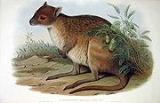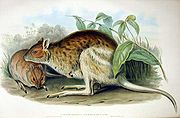
Spectacled Hare-wallaby
Encyclopedia
The Spectacled Hare-wallaby (Lagorchestes conspicillatus) is a species of macropod found in Australia
and New Guinea
. In Australia, a small sub-population is found on Barrow Island, while the mainland type is widespread, though in decline, across northern regions of the country.
, Hare-wallaby, small members of the Macropodidae family.
The Spectacled Hare-wallaby is found across northern Australia in tropical tussock
or spinifex
habitats. It can be found from Queensland
to Western Australia
. In 1997 it was discovered in the savanna country of southwest Papua New Guinea
. It is a solitary, nocturnal herbivore, and is considerably larger than its relatives. It is coloured grey-brown with golden tips and an orange circle around its eye, from which it gets its name. It builds its nests among the tough vegetation. When disturbed it hops off in a zigzag manner. The young are produced singly at any time of the year and become sexually mature at about a year old.
 The species was first described by John Gould
The species was first described by John Gould
, naming this hare-wallaby as Lagorchestes conspicillata, and provided an illustraion that was included in The Mammals of Australia
(Volume II) as plate 59. A separate description, Lagorchestes leichardti, was included in the same work as Pl. 58. This is now regarded as a subpopulation of the same species, which is sometimes described as a subspecies.
The subspecies L. conspicillatus conspicillatus is restricted to Barrow Island, Western Australia, but was once found throughout the Montebello Islands
. Predation by introduced species
and development on the island have led to a vulnerable status. L. conspicillatus leichardti, the mainland subspecies, was once regarded as a near-threatened status. The population of the species is in decline, largely due to reduction of habitat through land clearing. Concern also exists regarding the disappearance from arid parts of its far northern range. Reintroduction to former habitats has been proposed, following the related Western Shield
projects.
.
Australia
Australia , officially the Commonwealth of Australia, is a country in the Southern Hemisphere comprising the mainland of the Australian continent, the island of Tasmania, and numerous smaller islands in the Indian and Pacific Oceans. It is the world's sixth-largest country by total area...
and New Guinea
New Guinea
New Guinea is the world's second largest island, after Greenland, covering a land area of 786,000 km2. Located in the southwest Pacific Ocean, it lies geographically to the east of the Malay Archipelago, with which it is sometimes included as part of a greater Indo-Australian Archipelago...
. In Australia, a small sub-population is found on Barrow Island, while the mainland type is widespread, though in decline, across northern regions of the country.
Description
A species of LagorchestesLagorchestes
Lagorchestes is a genus containing all but one of the species referred to as hare-wallabies. It has four species, two of which are extinct:* †Lake Mackay Hare-wallaby, Lagorchestes asomatus...
, Hare-wallaby, small members of the Macropodidae family.
The Spectacled Hare-wallaby is found across northern Australia in tropical tussock
Tussock
Tussock most often refers to a small hillock of grassy, or grass-like plant growth, but may also refer to Plants and ecology, Insects.- Plants and ecology :*Tussock *New Zealand tussock grasslands*Serrated Tussock...
or spinifex
Spinifex
Spinifex may refer to:* Spinifex , a genus of grass which is indigenous to the coastal areas of Australasia and Indonesia* Triodia , a hummock grass of arid Australia, covering twenty percent of the Australian continent ** Spinifex resin* Spinifex people, or Pila Nguru, an Australian...
habitats. It can be found from Queensland
Queensland
Queensland is a state of Australia, occupying the north-eastern section of the mainland continent. It is bordered by the Northern Territory, South Australia and New South Wales to the west, south-west and south respectively. To the east, Queensland is bordered by the Coral Sea and Pacific Ocean...
to Western Australia
Western Australia
Western Australia is a state of Australia, occupying the entire western third of the Australian continent. It is bounded by the Indian Ocean to the north and west, the Great Australian Bight and Indian Ocean to the south, the Northern Territory to the north-east and South Australia to the south-east...
. In 1997 it was discovered in the savanna country of southwest Papua New Guinea
Papua New Guinea
Papua New Guinea , officially the Independent State of Papua New Guinea, is a country in Oceania, occupying the eastern half of the island of New Guinea and numerous offshore islands...
. It is a solitary, nocturnal herbivore, and is considerably larger than its relatives. It is coloured grey-brown with golden tips and an orange circle around its eye, from which it gets its name. It builds its nests among the tough vegetation. When disturbed it hops off in a zigzag manner. The young are produced singly at any time of the year and become sexually mature at about a year old.
Naming and taxonomy

John Gould
John Gould was an English ornithologist and bird artist. The Gould League in Australia was named after him. His identification of the birds now nicknamed "Darwin's finches" played a role in the inception of Darwin's theory of evolution by natural selection...
, naming this hare-wallaby as Lagorchestes conspicillata, and provided an illustraion that was included in The Mammals of Australia
The Mammals of Australia
The Mammals of Australia is a three volume work written and published by John Gould between 1845–63. It contains 182 illustrations by the author and its artist H. C. Richter...
(Volume II) as plate 59. A separate description, Lagorchestes leichardti, was included in the same work as Pl. 58. This is now regarded as a subpopulation of the same species, which is sometimes described as a subspecies.
Threat and status
The species was reviewed on the Red List (2008) as having the conservation status Least Concern.The subspecies L. conspicillatus conspicillatus is restricted to Barrow Island, Western Australia, but was once found throughout the Montebello Islands
Montebello Islands
The Montebello Islands, also known as the Monte Bello Islands, are an archipelago of around 174 small islands lying north of Barrow Island and off the Pilbara coast of north-western Australia. Montebello is Italian for "beautiful mountain"...
. Predation by introduced species
Introduced species
An introduced species — or neozoon, alien, exotic, non-indigenous, or non-native species, or simply an introduction, is a species living outside its indigenous or native distributional range, and has arrived in an ecosystem or plant community by human activity, either deliberate or accidental...
and development on the island have led to a vulnerable status. L. conspicillatus leichardti, the mainland subspecies, was once regarded as a near-threatened status. The population of the species is in decline, largely due to reduction of habitat through land clearing. Concern also exists regarding the disappearance from arid parts of its far northern range. Reintroduction to former habitats has been proposed, following the related Western Shield
Western Shield
Western Shield, managed by Western Australia's Department of Environment and Conservation, is a nature conservation program, safeguarding Western Australia's native animals and rescuing them from extinction...
projects.
Fossil record
A Spectacled Hare-wallaby fossil was discovered in Queensland dating up to 11,000 years ago from the early HoloceneHolocene
The Holocene is a geological epoch which began at the end of the Pleistocene and continues to the present. The Holocene is part of the Quaternary period. Its name comes from the Greek words and , meaning "entirely recent"...
.

